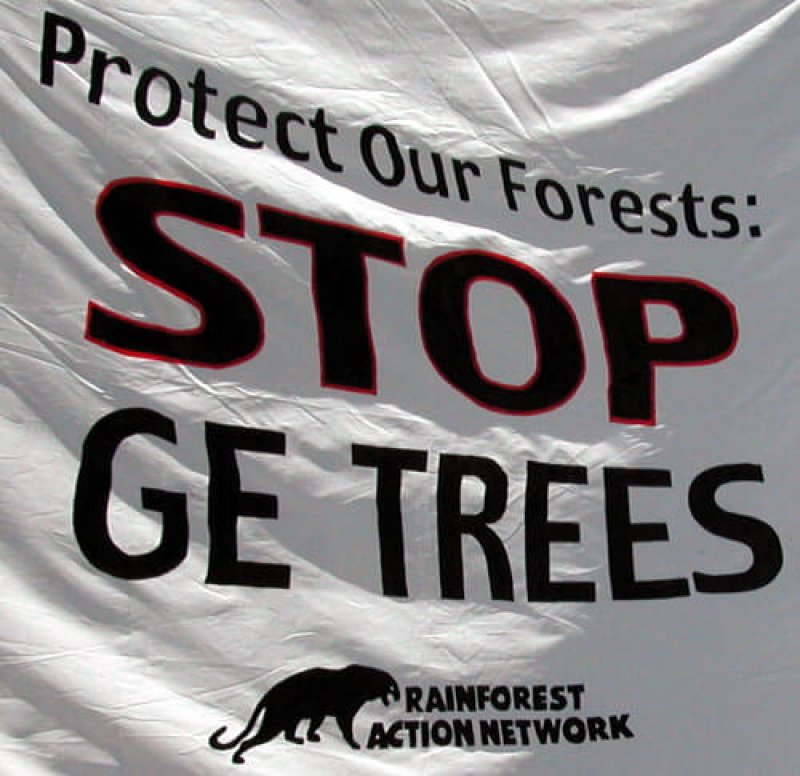No question; trees are valuable. They’re attractive. They provide shade and shelter for a number of animals (including us). Wood from trees is used for lumber, paper and other uses (sometimes even medicinal). They’re also effective at scrubbing carbon from the atmosphere and play a key role in the struggle against global climate change.
But their numbers are decreasing. Development, agricultural practices, fires and disease are slashing the acres of forests worldwide. Deforestation rates are in double digits in some regions, and threaten to worsen the effects of climate change worldwide if left unchecked.
GM trees a key fix for climate change
One method of restoring forests involves genetic modification of trees to encourage growth, resist disease, or possibly even to enhance photosynthesis, the process of converting carbon dioxide into energy and oxygen.
Researchers have been starting field trials to determine to what degree the technology can actually work on trees, and help restore the forest environment. But they’re running into opposition. Although this opposition has calmed considerably since the 2001 firebombing of a tree research laboratory at the University of Washington, anti-GMO activists have loudly denounced scientific experiments on transgenic trees as dangerous. Most recently:
- In March, a large group of women marched on the FuturaGene laboratory in Brazil, where the company was growing eucalyptus trees modified to increase biomass for fuels. The group purportedly was concerned over the effects the enhanced trees would have in a more natural environment, and proceeded to break into the facility and uproot the experimental seedlings. All to naught: the Brazilian government approved commercial use of the tree in April.
- Last summer, a number of environmental groups, including the Center for Food Safety, tried to convince the U.S. Department of Agriculture not to approve the testing and development of a GE loblolly pine by ArborGen, which altered the tree to increase its wood density. Even though the USDA noted that none of the genetic material used to enhance the tree was related to plant pests, anti-GMO activists claimed that, according to Rachel Smolker of BioFuel Watch, “This is deliberate, irreversible and completely irresponsible contamination of the environment with unknown and possibly devastating consequences.” And somehow, she alleged, ArborGen was able to produce this tree “without any assessments.”
According to anti-GMO activists, genetically engineered trees are a unique problem because of:
Cross contamination with wild relatives, unanticipated consequences of gene manipulations that may be expressed later in the tree’s lifecycle, or under particular circumstances, impacts on wildlife and unknown and unknowable risks which, as our experiences with GE food crops has demonstrated, can be severe.
Some of the risks are inherent to the fact that these GE trees are specifically intended to be grown en masse in tree plantations where the land is first cleared of all other life, the soils and waterways drained and drenched with fertilizers and toxic agrichemicals.
Do these arguments sound familiar? They should. They are being amplified by the same groups that oppose any other genetically modified plant or animal. The Genetic Literacy Project and others have shown how specific agricultural practices, and not genetic modification per se, can threaten biodiversity, And despite claims from anti-GMO activists, genetically modified crops, animals and yes, even trees, have indeed been subject to extensive testing.
Valid point from the anti-GMO lobby
One activist concern is that pollen or seeds from genetically modified trees could cross over and “contaminate” a non-GE forest. This may sound like the same sour notes that were played over the use of transgenic corn, forestry experiments have not yet shown one way or another that this could happen. And the reason we don’t know the answer is the fault of anti-GMO activists.
Unlike crops, forests take a very long time to grow. While a crop experiment can be finished in a year or less, understanding how a genetically modified tree may pollinate or mature can take years. So, a scientifically valuable field trial will require many years of study to determine patterns of pollination and other issues that may arise with genetic modification. Unfortunately, research on this scale has run into two obstacles: intensive lobbying by the Forest Stewardship Council and other groups that have prevented any tree trial from continuing for more than six years; and the precautionary principle adopted by the UN Convention on Biological Diversity, which environmental and anti-GMO groups have used to restrict field trials of trees.
According to emeritus president of the Missouri Botanical Garden Peter Raven, the CBD is
… preoccupied with GE crops. The so-called principle of ‘biosafety’ is not based on any valid scientific principles, and working it up through the Cartagena Protocol and by other means has given license to those who for personal reasons, presumably of a political nature, wish to vent their spleen.
Promise of GM forests
Regardless of these potential obstacles, genetic modification of trees looks promising. Traits that could be enhanced include wood chemistry; herbicide, insect and disease resistance; rate of growth; stature; salt tolerance; nutritional conditions; dormancy induction; onset of flowering, sterility; phytoremediation; cold tolerance; gene induction systems; and rootability, wrote Steven Strauss, a forestry scientist at the University of Oregon. It’s also no coincidence that most tree testing trials today are being developed in the United States, which did not sign the Convention on Biological Diversity.
Modifications could well rescue the American chestnut from an invasive fungus, and save it from the fate suffered by the American elm (which itself could be the beneficiary of genetic modification). The paper industry, long known for pollution and use of toxic chemicals, could change its processes if it handled trees that produced more pulp.
Andrew Porterfield is a writer, editor and communications consultant for academic institutions, companies and non-profits in the life sciences. He is based in Camarillo, California. Follow @AMPorterfield on Twitter.































